Peter Paul Rubens, The Presentation of the Portrait of Marie de’ Medici, c. 1622–25, oil on canvas, 394 x 295 cm (Musée du Louvre, Paris)
[0:00] [music]
Dr. Steven Zucker: [0:04] We’re in the Musée du Louvre in Paris, and we’re in an enormous room which is completely filled with 24 huge paintings by Peter Paul Rubens about the life of one woman.
Dr. Beth Harris: [0:16] Well, one very important woman, or at least she thought so. These were commissioned by Marie de’ Medici, a member of the very wealthy and powerful Italian Medici family, who married Henry IV, the king of France.
Dr. Zucker: [0:30] She hired Rubens, one of the most important painters in Europe during the Baroque period, to paint an elaborate cycle of the triumphs of her life. Then she put this series in her own mansion in what is now the Luxembourg Gardens, just south of the Louvre.
[0:45] Now this wasn’t an easy task, because although she was wealthy and she married a king, her life just wasn’t that interesting. She had children. One of them died in infancy. Her husband would ultimately die, and she would become regent of France until her son was old enough to rule himself, but besides that, there really wasn’t enough to fill 24 canvases.
Dr. Harris: [1:04] Rubens was very inventive and elevated these moments of her life by including mythological and allegorical figures that gave a sense that her position as queen was divinely ordained.
Dr. Zucker: [1:18] We certainly see that in the panel that shows Henry IV first gazing on her face in a portrait. It’s interesting, because in this case, we’re looking at a painting of a man who’s looking at a painting.
Dr. Harris: [1:29] You can see that he’s completely taken with the image of her. It looks as though he’s about to say, “Be still my heart.” He turns his body toward the portrait, his left hand is open, a gesture of being awed.
Dr. Zucker: [1:44] There’s such elegance in the way that he turns his body. It’s such an expression of the courtly manners of France in the 17th century.
Dr. Harris: [1:50] It’s funny, because we’re talking about Catholic Europe, but this is filled with ancient Greek and Roman mythological figures. We see Zeus and his wife Juno, also known as Hera.
Dr. Zucker: [2:02] We can identify them because of the eagle on Zeus’ side, who holds a thunderbolt, and the peacock behind Hera. You’re right, we’re not seeing Christian references that speak to the value of this couple, but rather this mythic cast of characters.
[2:16] Henry is taken by this portrait of Marie de’ Medici, and the portrait is being held aloft by Cupid, appropriately, the god we associate with love — Eros in Greek — and then Hymen, the god of marriage.
Dr. Harris: [2:28] Behind Henry is a personification of France, also urging him forward, as though saying, “Do this for France.”
Dr. Zucker: [2:36] There’s political imperative here as well. This is not only a match made of love, not only a match that has been sanctified by the gods, but this is an important political alliance as well.
Dr. Harris: [2:46] Right. This is an important moment for France.
Dr. Zucker: [2:48] And then we have this marvelous landscape, which is quite low in the composition, and we can see that there’s been a battle. In the foreground where the king has taken off his helmet, he’s put down his shield. We see two putti who are playing with these. It is as if the king is leaving behind war for love.
Dr. Harris: [3:04] We have this sense of wanting to leave everything behind for his great love for Marie de’ Medici.
Dr. Zucker: [3:09] Marie de’ Medici in the portrait is quite formal. She’s surrounded by this glorious collar, this very rich fabric, but she is close to the picture plane and looks rather straight out. There is a kind of flatness, whereas the king is in the process of movement.
Dr. Harris: [3:23] In typical Baroque fashion, the composition is structured using a series of diagonal lines. My eye starts at the bottom with those two putti leading up to Henry IV, the king, and the personification of France, across to the portrait, which occupies the center of the painting, the god of marriage, and then back up to Hera and Zeus.
[3:46] And so there’s a zigzagging that animates the entire composition with that portrait still in the center.
Dr. Zucker: [3:53] The complex pathways that Rubens uses to lead our eye around this canvas is masterful. There are these little vignettes. Look at the way that the personification of France touches so gently the king’s upper arm, and seems to be looking eagerly at the portrait.
[4:08] Almost as if she’s whispering in his ear. Then look at the Cupid, who looks back at the king’s face to judge his reaction and seems so pleased with his admiration.
Dr. Harris: [4:19] Or the Cupid below, who’s playing with Henry’s shield.
Dr. Zucker: [4:23] And looks directly out at us.
Dr. Harris: [4:24] Very mischievously.
Dr. Zucker: [4:26] Rubens produced the entire series within just a few years, but he was also known to have an enormous workshop of assistants. Rubens would have laid out the overall drawing and would’ve likely been responsible for the hands, for the faces, and presumably for the representation of the king and Marie de’ Medici, but he would’ve had lots of help with all that’s around them.
Dr. Harris: [4:46] It is so over-the-top.
Dr. Zucker: [4:48] The word ego doesn’t even suffice.
Dr. Harris: [4:51] Although it’s important to remember that she is just acting as a member of her class.
[4:55] [music]
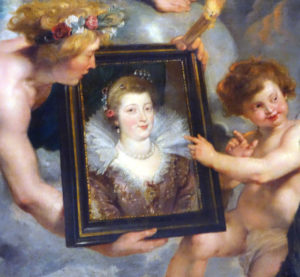
Peter Paul Rubens, The Presentation of the Portrait of Marie de’ Medici (detail), c. 1622–25, oil on canvas, 394 x 295 cm (Musée du Louvre, Paris; photo: Steven Zucker, CC BY-NC-SA 2.0)
Cupid’s arrow hits its mark
A young woman in a bejeweled dress with a stiff lace collar gazes confidently out of a simply framed, bust-length portrait placed at the very center of a large canvas. Her name is Marie de’ Medici, daughter of the Grandduke of Tuscany.
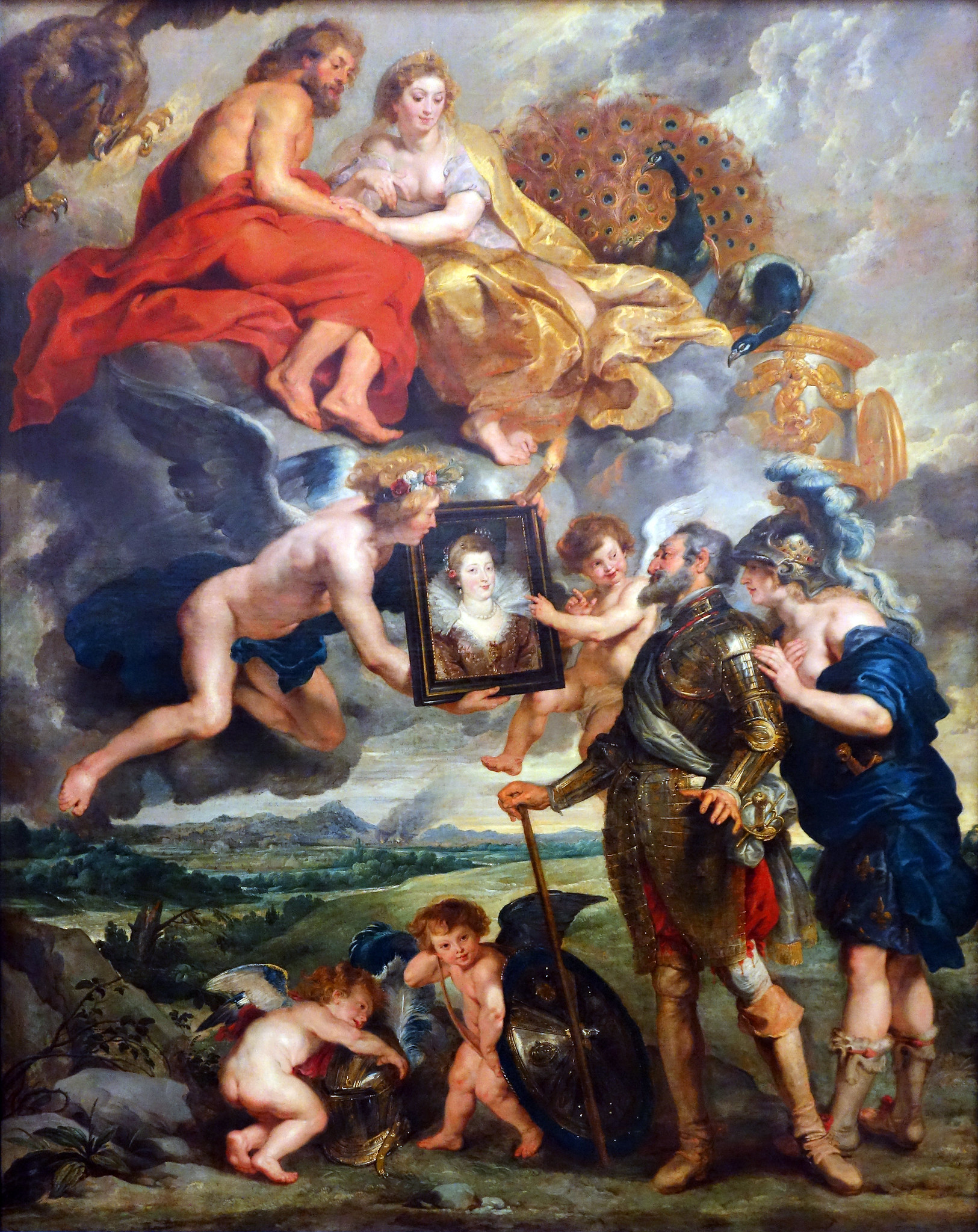
Peter Paul Rubens, The Presentation of the Portrait of Marie de’ Medici, c. 1622–25, oil on canvas, 394 x 295 cm (Musée du Louvre, Paris; photo: Steven Zucker, CC BY-NC-SA 2.0)
The ancient gods of marriage and love—Hymen and Amor (Cupid), to the left and right, respectively—hover in midair as they present this portrait to Henry IV, the king of France. Hymen holds in his left hand a flaming torch, symbolizing the ardor of love, while Cupid extols the virtues of the Medici princess. Cupid’s arrow has hit its mark; the king is smitten. He gazes up in gratitude, his left hand extended as he expresses his delight in his bride-to-be.
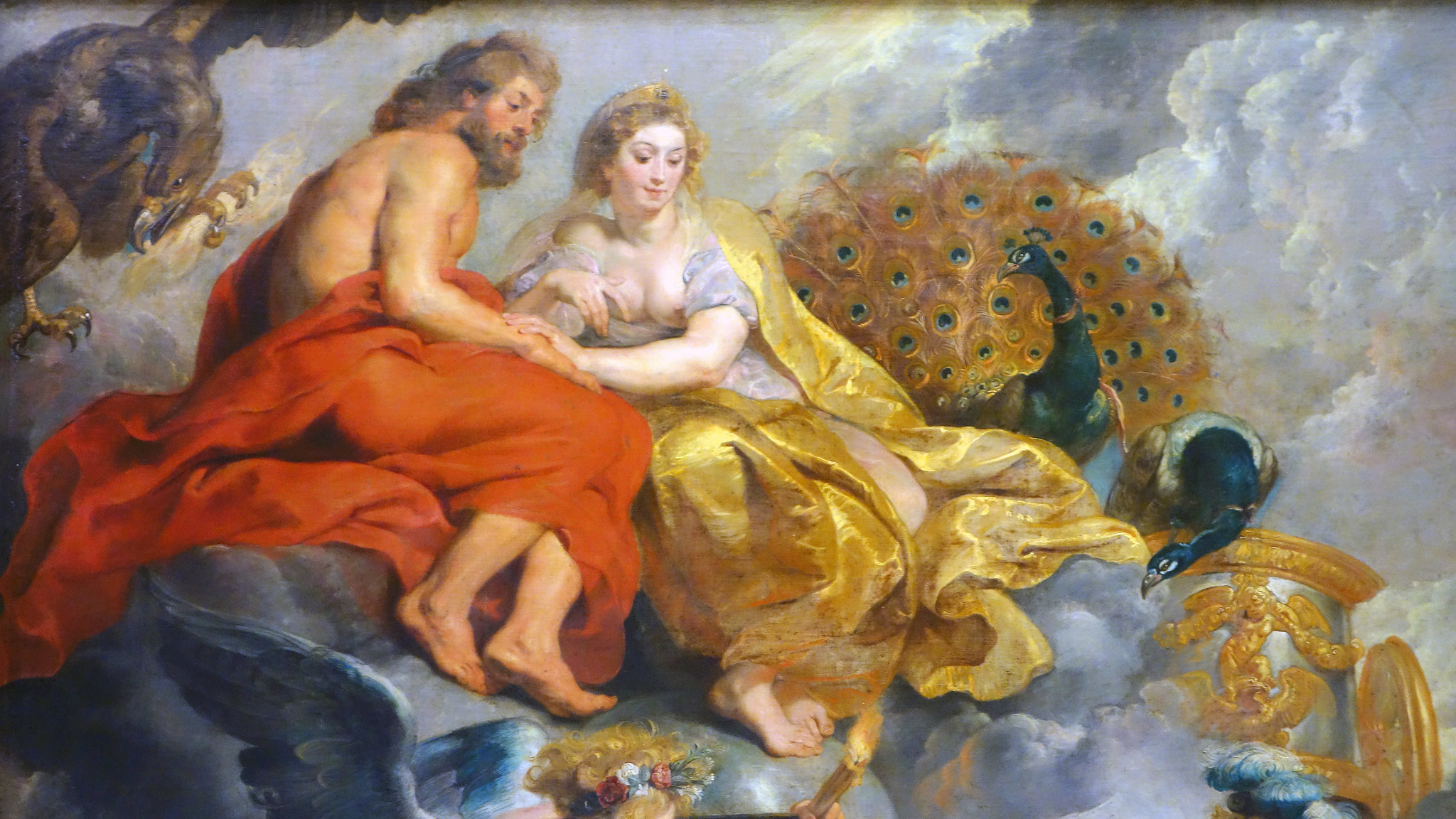
Jupiter and Juno (detail), Peter Paul Rubens, The Presentation of the Portrait of Marie de’ Medici, c. 1622–25, oil on canvas, 394 x 295 cm (Musée du Louvre, Paris; photo: Steven Zucker, CC BY-NC-SA 2.0)
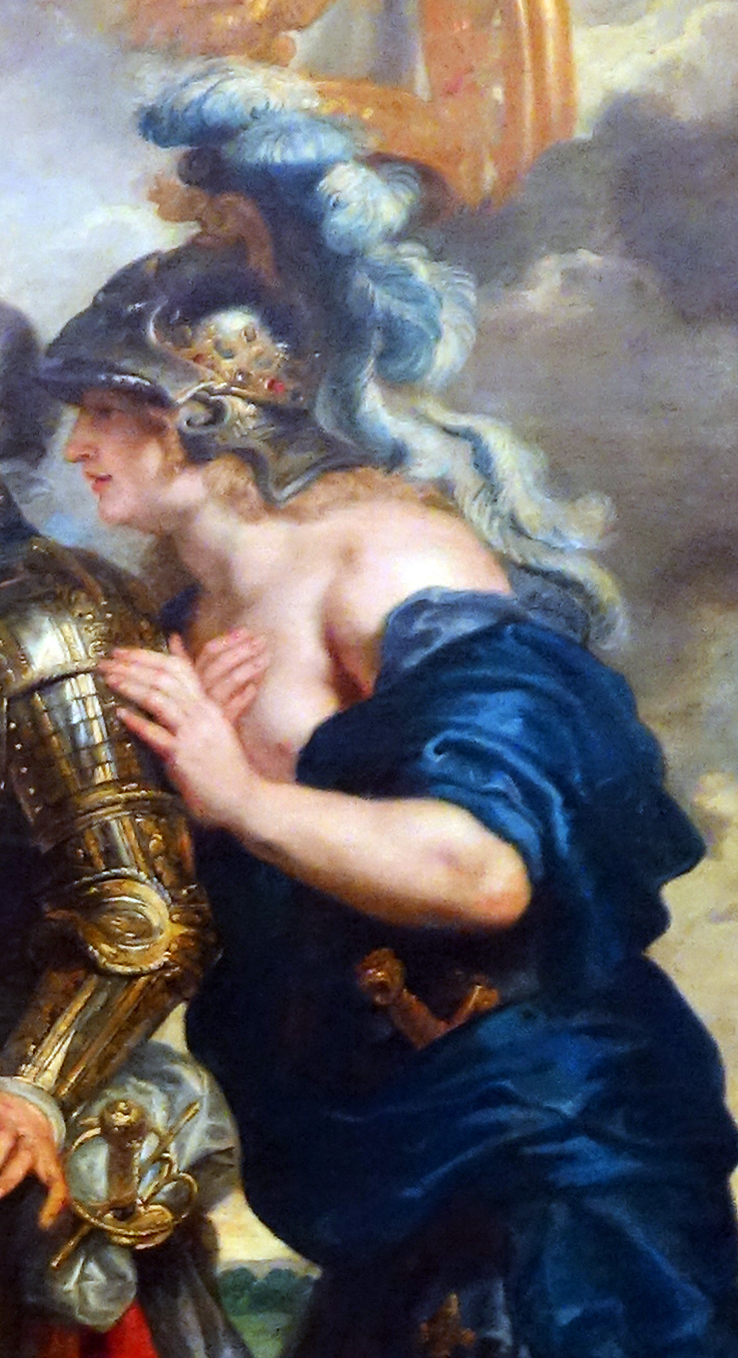
Personification of France (detail), Peter Paul Rubens, The Presentation of the Portrait of Marie de’ Medici, c. 1622–25, oil on canvas, 394 x 295 cm (Musée du Louvre, Paris; photo: Steven Zucker, CC BY-NC-SA 2.0)
From the heavens above, Jupiter and Juno, the king and queen of the Olympian gods, look down with approval, their own hands touching in a tender gesture of marital union. Jupiter’s fierce eagle, seen in the top left corner, looks away from the couple and clenches its lightening bolts in its talons. In contrast, Juno’s tamed peacock looks at the divine couple, while his mate cranes her neck to look at the portrait. A pink silk ribbon binds them together. The peahen perches on Juno’s chariot, directly above a golden relief of Cupid who balances a yoke-shaped garland (a symbol of marriage) on his shoulders as he playfully dances on the wings of a proud eagle. The message is clear: even the king of the gods can be subdued by love. Following Jupiter’s lead, Henry must also turn his attention to marriage.
However, this match is about politics as well as love. Behind Henry stands the personification of France, wearing a blue silk garment embroidered with gold fleur-de-lys (the coat of arms of the French monarchy) and an elaborate plumed helmet encircled by a gold crown. She gently touches Henry’s shoulder and whispers in his ear, assuring him that a match with the Medici princess is indeed good for the kingdom. France urges Henry to turn away from the field of battle, the aftermath of which is visible in the burning town in the background, and attend to hearth and home, for domestic matters are no less important to the survival of the monarchy than military exploits. Henry obliges; his helmet and shield—now the playthings of two tender cherubs—lie at his feet.

View of the Marie de’ Medici cycle by Peter Paul Rubens in the Louvre (photo: Steven Zucker, CC BY-NC-SA 2.0)
This canvas is the sixth in a series of twenty-four paintings on the life of Marie de’ Medici commissioned by the queen herself from Peter Paul Rubens in 1622 to adorn one of the two galleries in the Luxembourg Palace, her newly-built home in Paris. In both scale and subject matter, this cycle is unprecedented. Not only is it unique in its dedication to the major life events of a queen, but it also includes events that were both quite recent and quite humiliating. After Henry was assassinated in 1610, Marie—acting as regent for their young son, Louis XIII—ruled the kingdom of France for seven years. The position suited her; but many French nobles begrudged her power. Divisions in the court, including tensions with her own son, led to Marie’s exile from the Paris in 1617. The commission of the biographical cycle marked her reconciliation with Louis and her return to the capital city in 1620. It vindicated her reign as the queen of France.
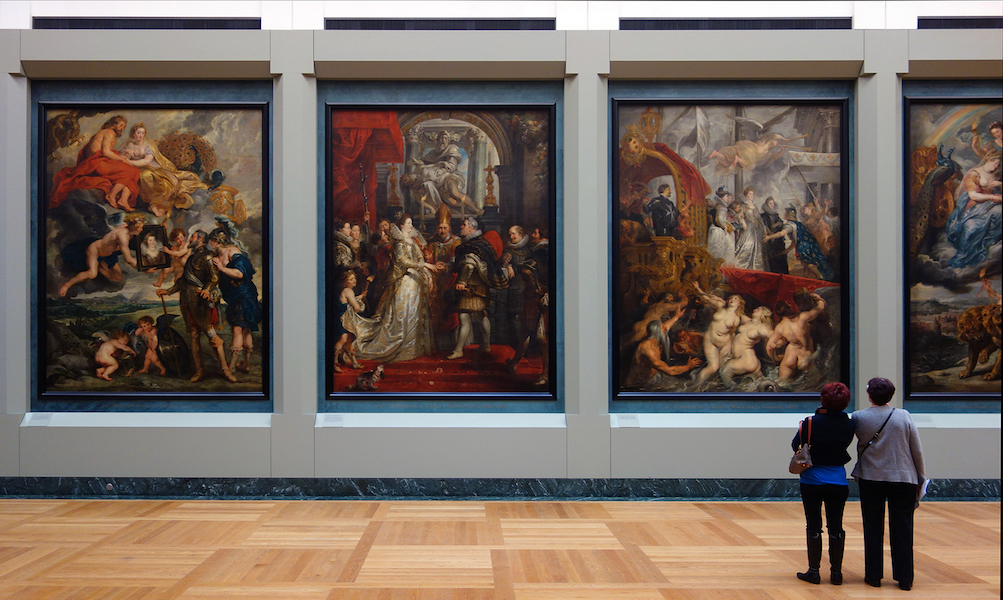
Peter Paul Rubens, three paintings from the 24-picture cycle Rubens painted for the Medici Gallery in the Luxembourg Palace, Paris. From left to right: Peter Paul Rubens, The Presentation of the Portrait of Marie de’ Medici, The Wedding by Proxy of Marie de’ Medici to King Henry IV, Arrival (or Disembarkation) of Marie de’ Medici at Marseilles, 1621–25, oil on canvas (Musée du Louvre, Paris; photo: Steven Zucker, CC BY-NC-SA 2.0)
The cycle idealizes and allegorizes Marie’s life in light of the peace and prosperity she brought to the kingdom, not through military victories but through wisdom, devotion to her husband and her adopted country, and strategic marriage alliances—her own as well as the ones she brokered for her children. This, at least, is the message she wished to convey and she worked closely with her advisors and Rubens to ensure her story was told as she saw fit.
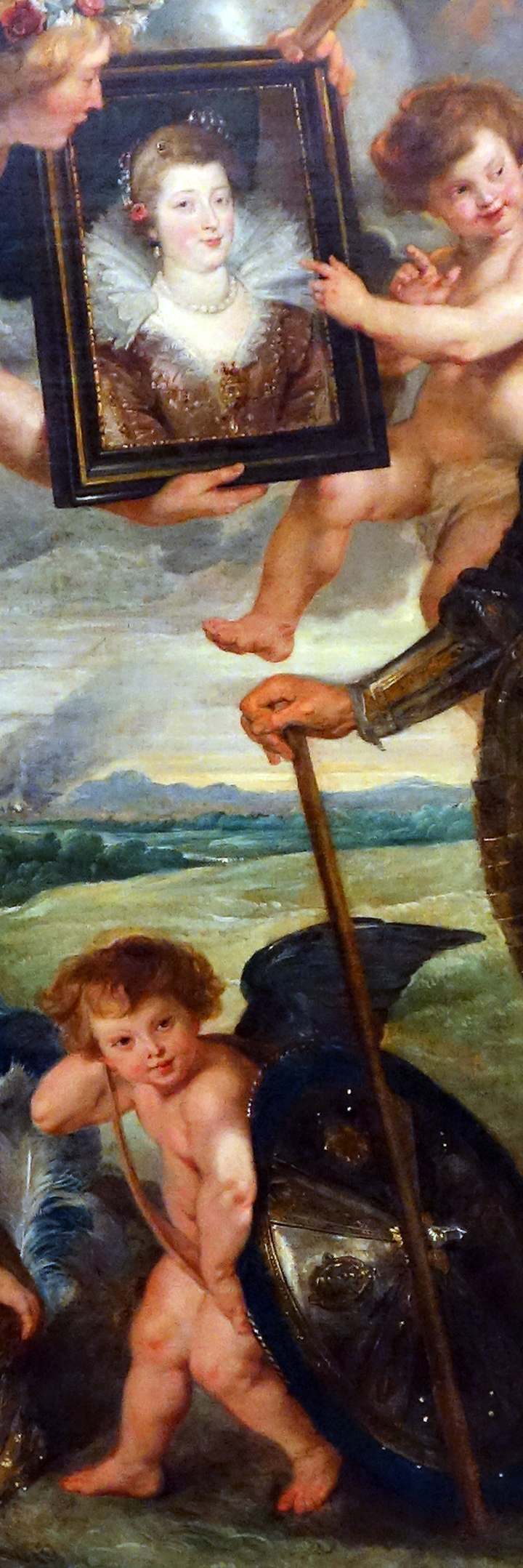
Marie de’ Medici and cherub (detail), Peter Paul Rubens, The Presentation of the Portrait of Marie de’ Medici, c. 1622–25, oil on canvas, 394 x 295 cm (Musée du Louvre, Paris; photo: Steven Zucker, CC BY-NC-SA 2.0)
The Presentation of the Portrait forms part of this agenda; it is an idealized portrayal of the conclusion in April of 1600 of marriage negotiations that were two years in the making. The painting presents Henry’s bethrothal to Marie de’ Medici as a union ordained by the gods, counseled by France, and inspired by Marie’s beauty and virtues. In reality, the merits of the union were extolled not by a soft-haired, fleshy Cupid, but by the alliance’s French and Italian proponents, one of whom reported that the portrait presented by the Florentine negotiators “pleased His Majesty exceedingly.” Henry, for his part, was distracted from the negotiations by his new mistress, whom he had promised to marry. Nevertheless, he recognized the political and financial necessity of the Medici marriage. When his advisor announced the finalization of the marriage contract, Henry exclaimed: “By God, let it be; there is nothing to be done about it, because for the good of my kingdom and my peoples, you say that I must be married, so I simply must be.”
For Henry, a Protestant who had converted to Catholicism upon ascending to the throne in 1593, a Catholic wife would assuage any concerns about his loyalty to the Catholic Church in France. Additionally, Marie’s hefty dowry eased Henry’s large debt to the Medici, major financial backers of his military activities. And, perhaps most importantly, Henry was nearing the age of 50 and had yet to father an heir, putting France’s future stability in danger. A fruitful union with Marie was key to this stability. In this matter, the 27-year old Marie did not disappoint, giving birth to a son one year after the wedding, and five additional children, four of whom survived to adulthood. Rubens asserts Marie’s successful role as wife and mother by establishing a dominant vertical axis through the center of the composition from Juno, with her exposed, full breasts, through Marie’s portrait to the chubby cherub directly below. Of all of the figures in the painting, Marie and the cherub are the only ones who look out at the viewer, pointedly reaffirming the centrality of Marie de’ Medici and of her royal progeny to the future of France.
The theme of peace, which runs throughout the cycle, was indeed furthered not only in France but in Europe by the marriage alliances brokered by Marie for her children: Louis XIII married a daughter of the Spanish king, her daughter Elisabeth married the heir to the Spanish throne (the future King Philip IV), and her daughter Henrietta married Charles I of England.
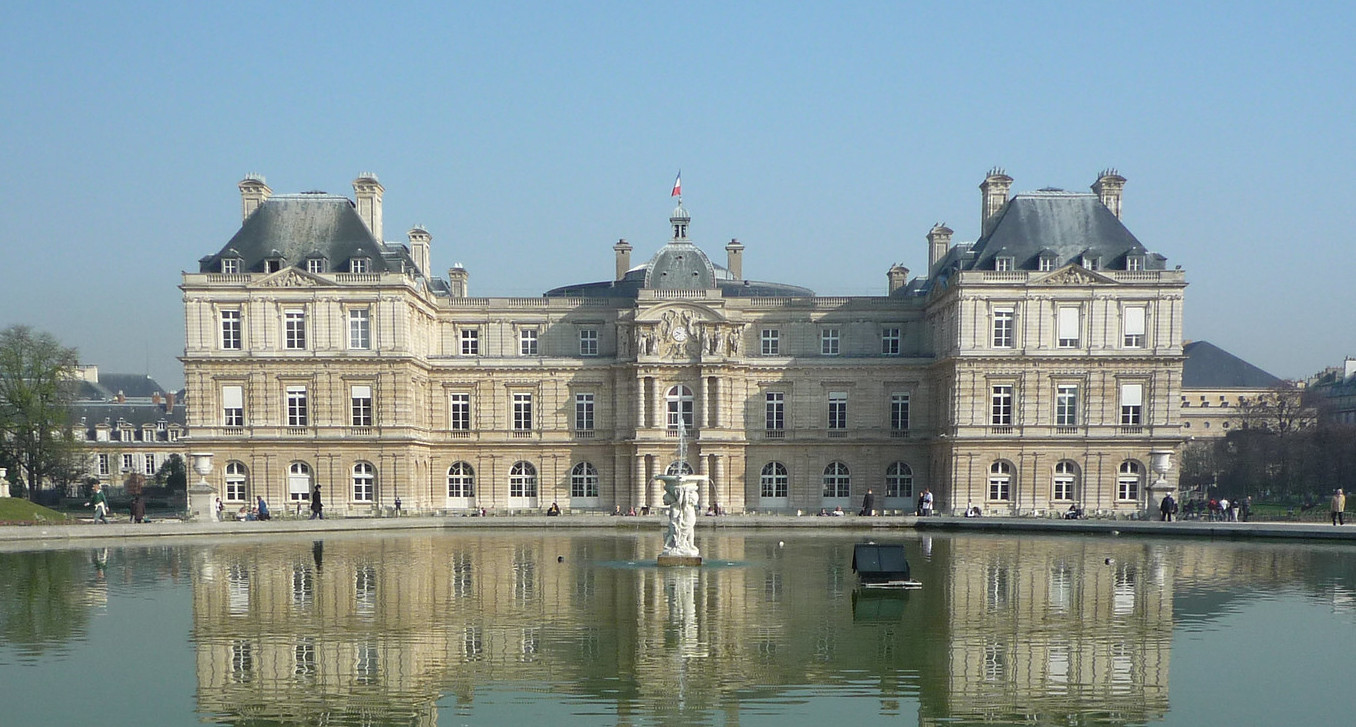
Luxembourg Palace (garden façade), Paris (photo: Steven Zucker, CC BY-NC-SA 2.0)
The pictorial cycle was installed in the Luxembourg Palace by 1625, in time for the Henrietta’s wedding festivities, thus enabling Marie to showcase her accomplishments to her many guests. Marie’s truce with her son Louis however was short lived and she died in exile in 1631. Despite the challenges of her life as she struggled to regain the power and influence she once had, Marie de’ Medici lived to hear herself proclaimed mother of three sovereigns, certainly an impressive legacy for the orphaned daughter of the Grandduke of Tuscany.

